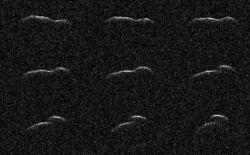Astronomy:(85990) 1999 JV6
 Radar images of 1999 JV6 taken by the Goldstone Radar on 12 January 2015 | |
| Discovery[1][2] | |
|---|---|
| Discovered by | LINEAR |
| Discovery site | Lincoln Lab's ETS |
| Discovery date | 13 May 1999 |
| Designations | |
| 1999 JV6 | |
| Minor planet category | Apollo · NEO · PHA |
| Orbital characteristics[1][2] | |
| Epoch 31 May 2020 (JD 2459000.5) | |
| Uncertainty parameter 0 | |
| Observation arc | 20.76 yr (7,582 days) |
| |{{{apsis}}}|helion}} | 1.3219 AU |
| |{{{apsis}}}|helion}} | 0.6946 AU |
| 1.0082 AU | |
| Eccentricity | 0.31110 |
| Orbital period | 1.01 yr |
| Mean anomaly | 194.713° |
| Mean motion | 0° 58m 24.915s / day |
| Inclination | 5.359° |
| Longitude of ascending node | 124.318° |
| 235.531° | |
| Earth MOID | 0.03152 AU |
| Physical characteristics | |
| Mean diameter | 0.451±0.026 km[1] |
| Rotation period | 6.538 h[1] |
| Geometric albedo | 0.095±0.023[1] |
| Xk (SMASS)[1] | |
| Absolute magnitude (H) | 20.2[1][2] |
(85990) 1999 JV6 (provisional designation 1999 JV6) is a sub-kilometer near-Earth asteroid and a potentially hazardous object of the Apollo group. It was discovered by astronomers of the LINEAR program at the Lincoln Laboratory's Experimental Test Site near Socorro, New Mexico. 1999 JV6 is a contact binary object consisting of two distinct lobes, as seen in radar images from various observatories including Arecibo and Goldstone in January 2015.
Close approaches

In January 2015, 1999 JV6 approached Earth within a distance of 32.4 lunar distances (0.0833 AU).[1] During the encounter, 1999 JV6 was observed by radar from the Arecibo, Green Bank, and Goldstone observatories.[3] In January 2016, 1999 JV6 has made another close approach at a distance of 12 lunar distances (0.032 AU), several times closer than the encounter in 2015.[1][3]
The Minor Planet Center has classified 1999 JV6 as a potentially hazardous asteroid due to its large size and small Earth minimum orbit intersection distance (MOID) of 0.03 AU.[4][1]
Physical characteristics
1999 JV6 was discovered in May 1999 by the Lincoln Near-Earth Asteroid Research (LINEAR) program at the Lincoln Laboratory's Experimental Test Site near Socorro, New Mexico. Most properties of 1999 JV6 have been determined through photometry, spectroscopy, infrared radiometry, and radar imaging.[3]
Binzel et al. (2001) have found that 1999 JV6 has a spectral class of an Xk-type asteroid. Thermal infrared observations using the WISE spacecraft by Mainzer et al. (2011) and the Spitzer Space Telescope by Mueller et al. (2011) give a diameter of 0.45 km (0.28 mi). Warner et al. (2014, 2015) suggest that 1999 JV6 has a highly elongated shape due to its large light curve amplitude of 0.9 magnitudes. Based on 1999 JV6's large brightness changes, they measured a rotation period of 6.54 hours. In January 2015, radar imaging by the Arecibo Observatory and the Green Bank Observatory confirmed 1999 JV6's elongated shape and provided delay-Doppler images used to obtain a preliminary estimate of a 3D model for its shape. The radar data reveal an apparent concavity and suggest that 1999 JV6 is a contact binary.[4]
References
- ↑ 1.00 1.01 1.02 1.03 1.04 1.05 1.06 1.07 1.08 1.09 "JPL Small-Body Database Browser: 85990 (1999 JV6)". Jet Propulsion Laboratory. 15 February 2020. https://ssd.jpl.nasa.gov/sbdb.cgi?sstr=2085990. Retrieved 30 April 2020.
- ↑ 2.0 2.1 2.2 "(85990) = 1999 JV6". Minor Planet Center. International Astronomical Union. https://minorplanetcenter.net/db_search/show_object?object_id=85990. Retrieved 30 April 2020.
- ↑ 3.0 3.1 3.2 "Goldstone Radar Observations Planning: 1999 JV6, 2001 WL15, and Toro". https://echo.jpl.nasa.gov/asteroids/1999JV6/1999JV6_planning.v2.html.
 This article incorporates text from a publication now in the public domain:
This article incorporates text from a publication now in the public domain:
- ↑ 4.0 4.1 Rożek, A.; Lowry, S. C.; Nolan, M. C.; Taylor, P. A.; Benner, L. a. M.; Fitzsimmons, A.; Zegmott, T. J.; Weissman, P. R. et al. (2019-11-01). "Shape model and spin-state analysis of PHA contact binary (85990) 1999 JV6 from combined radar and optical observations" (in en). Astronomy & Astrophysics 631: A149. doi:10.1051/0004-6361/201936302. ISSN 0004-6361. https://www.aanda.org/articles/aa/abs/2019/11/aa36302-19/aa36302-19.html.
External links
- Goldstone Radar Observations Planning: 1999 JV6, 2001 WL15, and Toro, JPL Asteroid Radar Research
- 3D model of the asteroid
- (85990) 1999 JV6 at NeoDyS-2, Near Earth Objects—Dynamic Site
- Ephemeris · Obs prediction · Orbital info · MOID · Proper elements · Obs info · Close · Physical info · NEOCC
- (85990) 1999 JV6 at ESA–space situational awareness
- (85990) 1999 JV6 at the JPL Small-Body Database
 |

